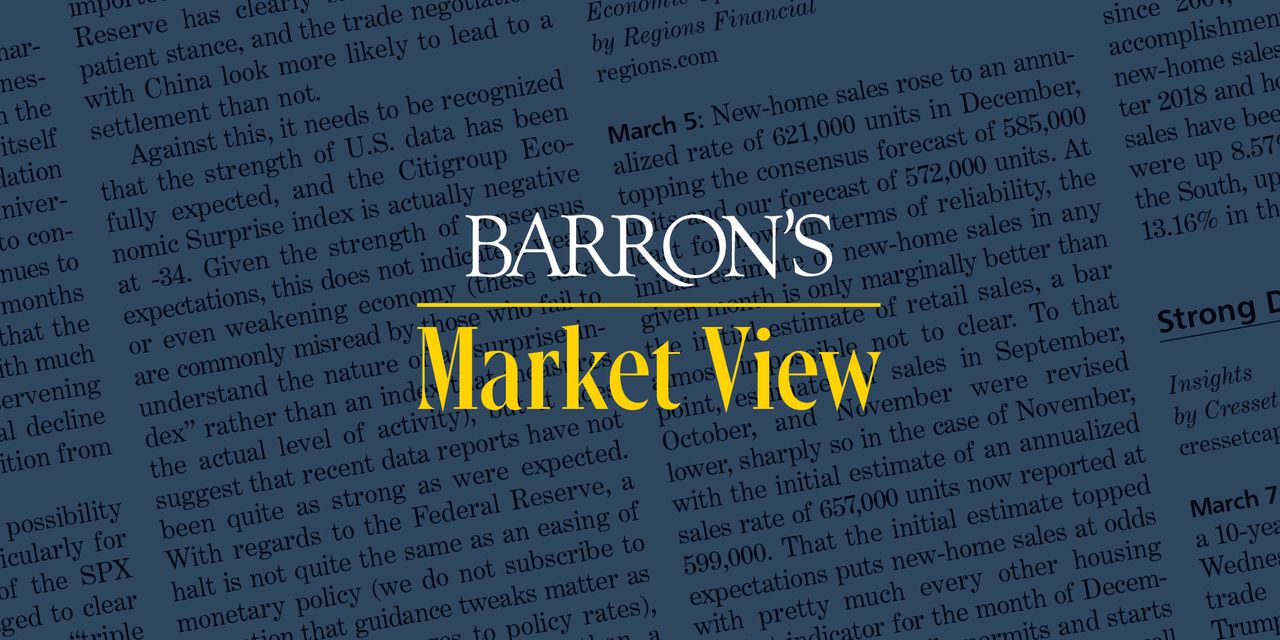This commentary was issued recently by money managers, research firms, and market newsletter writers and has been edited by Barron’s.
Technical and Monetary Investment Analysis
InvesTech Research
July 21: Consumer spending has supported the economy for much of the past few years, bolstered by trillions of dollars in stimulus payments and other benefits. Excess savings and lockdowns have helped fuel this strength, though it may be starting to slow.
Within retail sales, same-store sales measures growth in revenue from existing (not new) store locations. Johnson Redbook’s latest same-store sales year-over-year figure went negative, indicating fewer purchases compared with a year ago. If this continues to deteriorate, it implies that consumers are spending less overall than before and a recession becomes more probable.
James B. Stack
U.S. Interest Expense Swells
Quarterly Newsletter
Robinson Value Management
July 20: Our federal government’s interest expense is now 19.3% of receipts, up from 13.5% a year ago. Its $31.5 trillion debt is now 1.2 times the size of our gross national product and has an average maturity of 5.2 years. This means that, on average, about $750 billion must be refinanced each quarter. In doing so, the interest rate rises from approximately 1.9% to 3% currently paid on outstanding notes and bonds to 3.8% to 5.5% for newly issued notes and bonds.
In addition, another roughly $350 billion of new issuance takes place each quarter just to fund the current deficit. Interest paid on each new issuance is an entirely new expense for Congress.
So, roughly $1.1 trillion of federal debt issuance is required each quarter, i.e., approaching $1 billion each week—all in a nonrecessionary environment! The approximate 2% increase in the interest rate paid on the $750 billion in refinanced debt, plus 4.5% on the $350 billion of new debt, results in approximately $30 billion in additional interest payments each quarter and thereafter.
For perspective, continuing in this way for merely two years would raise the interest payments on federal debt by nearly $1 trillion annually, an amount equal to more than half of all discretionary spending by Congress ($1.7 trillion in 2022).
This debilitating growth in interest service expense is already happening. The Bureau of Economic Analysis reported that from the first quarters of 2022 to 2023, interest payments by the federal government rose from an annual rate of $603 billion to $929 billion, a $325 billion increase. This was a 54% rise in one year, increasing the average interest rate paid on federal debt from 2.1% to 3.01%. As long as interest rates hold here or decline, the eventual damage to the budget in the near future should peak at about $500 billion annually. It is a profound imposition, illustrative of the fragility of our government’s functioning and our economic stability.
Amy Abbey Robinson, Charles W. Robinson III
Liquidity’s Ample. Here’s Why.
The Weekly Speculator
Marketfield Asset Management
July 20: Liquidity continues to be ample, despite the supposed quantitative tightening pursued by the Federal Reserve Bank. This is partly due to the emergency injections into the regional banking system made last March, but also because the massive sums dumped into the Fed’s repo facility during Covid are finally starting to be drawn down and used to purchase the very large issuance of short-term Treasuries that has followed the end of the debt-ceiling standoff.
We have always wondered if this would occur in a tightening cycle and act to counterbalance the reduction of Treasury and mortgage-backed holdings by the Fed. This has certainly been the case since mid-May, with repo usage falling much faster than asset sales are taking place, which effectively increases the liquidity provided by the Fed into the overall financial system.
We have seen a few articles written about this in recent days, and it will be interesting to see if it is an item of discussion during Fed Chair Jerome Powell’s presser on Wednesday.
Michael Shaoul and Timothy Brackett
Dow Theorists, Rejoice!
Technical Strategy
Fundstrat
July 18: Dow Theorists are likely rejoicing, as the
Dow Jones Industrial Average
and the
Dow Jones Transportation Average
[transports] have just achieved meaningful base breakouts back above former consolidation base highs.
This is particularly helpful in allowing the DJIA and transports to play catch-up to the
Nasdaq Composite
and the
S&P 500
index, and eliminates most of the intramarket divergences. When multiple indexes begin to confirm movement above a prior intermediate-term peak, this is more meaningful and constructive than when one index is “going it alone.”
My thinking is that this will allow the DJIA to push back eventually to all-time highs, which lie just below 37,000. These shallow base breakouts tend to be quite bullish technically, and the DJIA appears like a better risk/reward for the next couple of months than extended indexes such as the Nasdaq.
Mark L. Newton
Ukraine Grain Outlook
Commodities Daily
ING Think
July 18: The Black Sea Grain Initiative expired yesterday with Russia not willing to agree on a further extension of the deal. The news saw Chicago Board of Trade wheat at one stage trade more than 4% higher on the day.
However, prices eventually settled down on the day. While the end of the deal is certainly supportive of grain prices, given that Ukraine was expected to make up about 10% of global corn exports and about 5% of global wheat exports, we don’t believe that it will mean significantly higher prices….
For wheat, the impact would be more meaningful if all Ukrainian wheat exports (10.5 megatons) were lost. However, this is a worst-case scenario. In reality, we will not lose all Ukrainian export volumes, given that we will see a pickup in flows via the Danube and through the European Union. Admittedly, though, this would be a more expensive route, while capacity constraints may be an issue.
Warren Patterson, Ewa Manthey
To be considered for this section, material, with the author’s name and address, should be sent to [email protected].
Read the full article here





